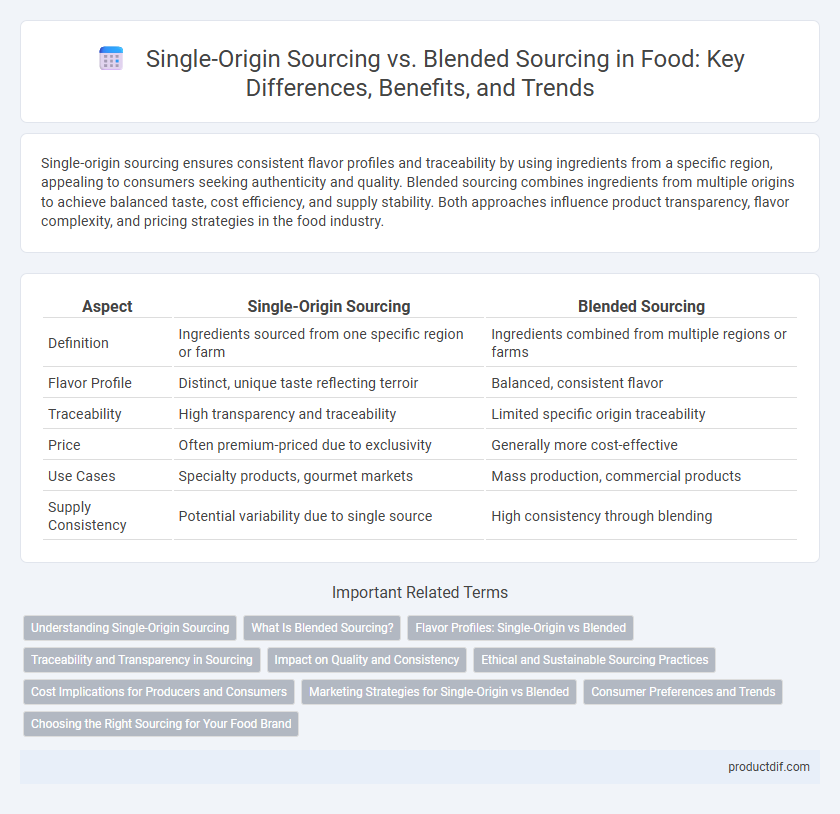Single-origin sourcing ensures consistent flavor profiles and traceability by using ingredients from a specific region, appealing to consumers seeking authenticity and quality. Blended sourcing combines ingredients from multiple origins to achieve balanced taste, cost efficiency, and supply stability. Both approaches influence product transparency, flavor complexity, and pricing strategies in the food industry.
Table of Comparison
| Aspect | Single-Origin Sourcing | Blended Sourcing |
|---|---|---|
| Definition | Ingredients sourced from one specific region or farm | Ingredients combined from multiple regions or farms |
| Flavor Profile | Distinct, unique taste reflecting terroir | Balanced, consistent flavor |
| Traceability | High transparency and traceability | Limited specific origin traceability |
| Price | Often premium-priced due to exclusivity | Generally more cost-effective |
| Use Cases | Specialty products, gourmet markets | Mass production, commercial products |
| Supply Consistency | Potential variability due to single source | High consistency through blending |
Understanding Single-Origin Sourcing
Single-origin sourcing ensures that food products, such as coffee or chocolate, come from a specific geographic location, highlighting unique flavor profiles and supporting traceability and sustainability. This method allows consumers to experience distinct regional characteristics influenced by soil, climate, and farming practices. Emphasizing provenance, single-origin sourcing fosters transparency and often promotes ethical trade practices in the food supply chain.
What Is Blended Sourcing?
Blended sourcing in food production involves combining ingredients from multiple origins to achieve consistent flavor, quality, and supply stability. This approach allows manufacturers to balance cost and availability while meeting consumer expectations for taste and texture. By carefully selecting and mixing components from various regions, blended sourcing enhances product uniformity and reduces dependency on a single source.
Flavor Profiles: Single-Origin vs Blended
Single-origin sourcing highlights the unique and distinct flavor profiles of a specific region, emphasizing terroir-driven nuances such as floral, fruity, or earthy notes. Blended sourcing combines beans or ingredients from various origins to create a balanced and consistent flavor profile, often enhancing complexity and reducing bitterness. Single-origin products appeal to connoisseurs seeking transparency and distinctive taste, while blends cater to consumers desiring a harmonious and approachable flavor experience.
Traceability and Transparency in Sourcing
Single-origin sourcing emphasizes traceability by allowing precise tracking of food products from a specific farm or region, ensuring transparency in production methods and quality standards. Blended sourcing combines ingredients from multiple origins, making traceability more complex but offering consistency in flavor and supply stability. Enhanced digital tools and blockchain technology are increasingly used to improve transparency and traceability in both sourcing approaches.
Impact on Quality and Consistency
Single-origin sourcing delivers distinct flavor profiles by preserving unique terroir characteristics, enhancing product quality for connoisseurs seeking authenticity. Blended sourcing ensures consistency and balanced taste by combining beans or ingredients from multiple origins, reducing variability caused by seasonal or regional differences. Quality control in single-origin products depends heavily on specific harvest conditions, while blended sourcing offers reliability in taste and texture across batches.
Ethical and Sustainable Sourcing Practices
Single-origin sourcing emphasizes transparency and accountability by tracing ingredients back to a specific farm or region, which often supports fair labor practices and environmental stewardship. Blended sourcing, while offering cost efficiencies, can sometimes obscure the supply chain, posing challenges for verifying ethical and sustainable standards. Prioritizing single-origin suppliers with certifications such as Fair Trade, Rainforest Alliance, or Organic ensures a higher commitment to responsible sourcing and environmental sustainability.
Cost Implications for Producers and Consumers
Single-origin sourcing often leads to higher production costs due to limited supply and stringent quality control, resulting in premium pricing for consumers seeking unique flavors. Blended sourcing allows producers to lower costs by mixing various origins, offering more affordable products with consistent taste profiles. Consumers benefit from blended options through accessibility and price stability, while producers balance quality and cost efficiency in their supply chains.
Marketing Strategies for Single-Origin vs Blended
Single-origin sourcing emphasizes traceability and unique flavor profiles, appealing to consumers who value authenticity, ethical production, and artisanal quality, which marketers leverage through storytelling and transparency campaigns. Blended sourcing targets consistent taste and affordability, often promoted by highlighting flavor balance, reliability, and value for everyday consumption. Marketing strategies for single-origin prioritize niche targeting and premium positioning, while blended sourcing focuses on broad appeal and price competitiveness.
Consumer Preferences and Trends
Consumers increasingly favor single-origin sourcing for its traceability, distinctive flavor profiles, and perceived quality, driving demand for transparency and ethical production. Blended sourcing remains popular for consistency and affordability, appealing to those prioritizing balanced taste and cost-effectiveness. Market trends reveal a growing niche for premium single-origin products alongside staple blends catering to everyday consumption.
Choosing the Right Sourcing for Your Food Brand
Single-origin sourcing emphasizes unique flavor profiles and traceability, appealing to consumers prioritizing authenticity and quality, whereas blended sourcing offers consistency and cost-efficiency, ideal for large-scale production. Food brands must evaluate market positioning, target demographics, and supply chain reliability to determine the optimal sourcing strategy. Balancing exclusivity with scalability ensures brand differentiation and sustainable growth in competitive food markets.
Single-origin sourcing vs Blended sourcing Infographic

 productdif.com
productdif.com